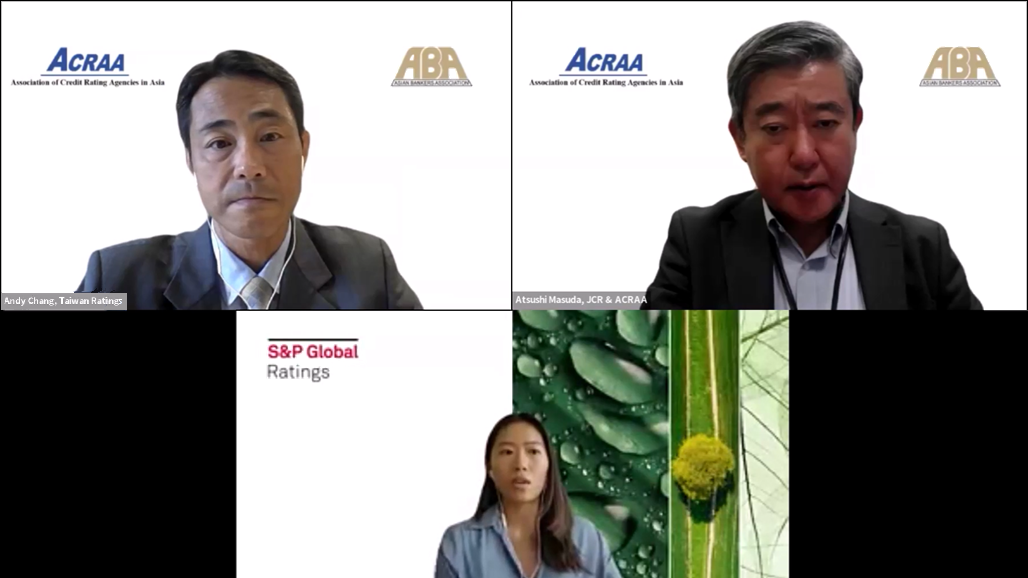
Summary
Andy Chang, Sr. Director at Taiwan Ratings Corp.,
Mr. Andy Chang introduced the session, emphasizing the growing importance of sustainable and transition finance for global banks to achieve net-zero targets by 2050 and avoid greenwashing. He highlighted the need for effective climate transition assessments to support a low-carbon, climate-resilient future. Mr. Chang proceeded to introduce the two expert speakers: Mr. Atsushi Masuda and Ms. Joyee Lam.
Atsushi Masuda, JCR & ACRAA
Mr. Masuda’s presentation focused on the role of transition finance in Japan, its frameworks, and case studies. He covered the following points:
Concerning the definition of Transition Finance, Mr. Masuda said that Transition finance is crucial for sectors with high carbon emissions, providing flexibility for achieving sustainability goals and that it bridges the gap for industries needing advanced technologies (e.g., hydrogen, ammonia) to transition toward Paris Agreement targets.
Mr. Masuda said that the Key Principles of Transition Finance must be aligned with ICMA’s global standards, and must satisfy these four elements:
- Long-term strategy: Must align with science-based goals like those in the Paris Agreement.
- Core business alignment: Companies’ strategies must target material improvements in emissions reductions.
- Scientific basis: Emission reduction plans should be realistic, credible, and backed by science.
- Transparency: Clear reporting of investment plans, targets, and progress is essential.
He also presented the Kansai Electric Power Company case where two important issues were developed. One was the energy transition through long-term commitments like shifting from coal to hydrogen and ammonia technologies; and the company’s alignment with government-defined roadmaps highlights industry-specific strategies for emission reductions.
Another important point was the Sovereign Transition Bonds as Japan was the first to issue sovereign transition bonds, evaluated by JCR. These bonds link financing mechanisms, such as carbon pricing, with investments in research and infrastructure, exemplifying innovative approaches to sustainable finance.
He also explained that Japan’s Commitment to Green Transformation (GX) has three objectives:
- Aims to mobilize ¥150 trillion (~$1 trillion USD) for transition financing, including infrastructure development, hydrogen distribution, and renewable energy projects.
- Includes initiatives like 100% EV adoption and 38% renewable energy in the energy mix by 2050.
- Japan’s efforts are supported by international forums such as the GX League and the Asia Zero Emission Community.
A key element of Mr. Masuda’s presentation was the differentiation between Transition and Green Finance. He said that Transition finance extends beyond green finance by addressing sectors that are traditionally ineligible for green bonds, requiring comprehensive strategies and innovations.
Mr. Masuda concluded by emphasizing Japan’s leadership in setting standards and providing second-party opinions for transition finance.
Ms. Joyee Lam, Associate in Sustainable Finance at S&P Global Rating.
(1) 2024 Forecast: She said that Sustainable bond issuance projected between $0.95–1.95 trillion, representing 14% of total bond issuance; and with the projection that Green bonds are expected to dominate issuance.
(2) Regional Insights: ASEAN markets show increased presence in sustainable bonds, while the Asia-Pacific contributed 25% of global sustainable bond issuance in 2023, led by South Korea, Japan, and China (80% of regional issuance over 5 years).
(3) S&P Global’s Role: Ms. Lam said that between July 2022 and February 2024, it (?) produced 72 SPOs and assigned 145 green shades using an integrated methodology. Also, Renewable energy, clean transportation, and climate change adaptation frequently received dark or medium green shades.
- Dark Green: Fully aligned with a low-carbon, climate-resilient future.
- Medium Green: Significant progress toward low-carbon alignment but with improvement areas.
- Light Green: Transition steps critical in the near term but may risk emissions lock-in.
- Non-Green (Yellow, Orange, Red): Activities with significant environmental risks or incompatible with a low-carbon future.
Ms. Lam pointed out that there are several key considerations on the Shading methodology such as (1) Nature and location of activities, (2) Exposure to climate risks and biodiversity impacts, and (3) Supply chain and lifecycle considerations.
Concerning the Climate Transition Assessment (CTA), Ms. Lam said that its purpose is two-fold: (1) Assess companies’ current and future alignment with climate transition goals, and (2) Apply shading methodology to entities’ financial mix and transition plans.
The Evaluation Criteria includes Metrics and targets, investments, governance, and external regulatory/geographical factors, as well as distinguishes between shades based on entities’ ability to meet low-carbon targets. She also mentioned the shading examples in Hard-to-Abate Sectors:
- Dark Green: Green hydrogen projects with environmental safeguards.
- Medium Green: Bio-based feedstock with some indirect environmental risks.
- Light Green: Transitional projects using fossil fuels with future green compatibility.
Ms. Lam argued that currently, Transition finance faces two major challenges: (1) Barriers: Technological and financial constraints in hard-to-abate sectors (responsible for 30% of global emissions), and (2) Concerns over greenwashing deterring market participation.
Nevertheless, she observed positive developments in the Regulatory environment such as Hong Kong and Singapore taxonomies and the creation of Transition-labeled bonds account for <0.5% of total sustainable bond issuance. To further elaborate on her presentation, she pointed out case studies on a real estate company (Switzerland) and EV charging equipment company (Finland)
In conclusion, Ms. Lam emphasized the critical role of transparent transition financing and encouraged attendees to explore S&P’s public CTA reports for a deeper understanding of the methodology and insights.
A video recording of the webinar can be viewed at the ABA YouTube HERE.


